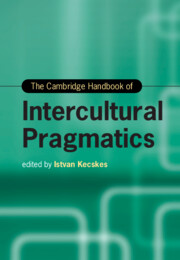Book contents
- The Cambridge Handbook of Intercultural Pragmatics
- Cambridge Handbooks in Language and Linguistics
- The Cambridge Handbook of Intercultural Pragmatics
- Copyright page
- Contents
- Figures
- Tables
- Acknowledgment
- Contributors
- Introduction The Rise of Intercultural Pragmatics
- Part I Theoretical Foundation
- Part II Key Issues in Intercultural Pragmatics Research
- Part III Interface of Intercultural Pragmatics and Related Disciplines
- Part IV Intercultural Pragmatics in Different Types of Communication
- 21 Visual and Multimodal Communication across Cultures
- 22 Intercultural Teamwork via Videoconferencing Technology: A Multimodal (Inter)action Analysis
- 23 Intercultural Communication in Computer-Mediated Discourse
- 24 Intercultural Aspects of Business Communication
- 25 Intercultural Pragmatics in Healthcare Communication
- 26 Academic and Professional Discourse in Intercultural Pragmatics
- 27 The Dynamic Model of Meaning Approach: Analyzing the Interculturality of Conspiracy Theory in Far-Right Populist Discourses
- Part V Language Learning
- Index
- References
26 - Academic and Professional Discourse in Intercultural Pragmatics
from Part IV - Intercultural Pragmatics in Different Types of Communication
Published online by Cambridge University Press: 29 September 2022
- The Cambridge Handbook of Intercultural Pragmatics
- Cambridge Handbooks in Language and Linguistics
- The Cambridge Handbook of Intercultural Pragmatics
- Copyright page
- Contents
- Figures
- Tables
- Acknowledgment
- Contributors
- Introduction The Rise of Intercultural Pragmatics
- Part I Theoretical Foundation
- Part II Key Issues in Intercultural Pragmatics Research
- Part III Interface of Intercultural Pragmatics and Related Disciplines
- Part IV Intercultural Pragmatics in Different Types of Communication
- 21 Visual and Multimodal Communication across Cultures
- 22 Intercultural Teamwork via Videoconferencing Technology: A Multimodal (Inter)action Analysis
- 23 Intercultural Communication in Computer-Mediated Discourse
- 24 Intercultural Aspects of Business Communication
- 25 Intercultural Pragmatics in Healthcare Communication
- 26 Academic and Professional Discourse in Intercultural Pragmatics
- 27 The Dynamic Model of Meaning Approach: Analyzing the Interculturality of Conspiracy Theory in Far-Right Populist Discourses
- Part V Language Learning
- Index
- References
Summary
Academic writers with different linguistic backgrounds communicate scientific findings following objective norms, although they do so in different ways, as is evidenced in intercultural studies. This chapter focuses on the identification of boosters and hedges used by Spanish and Chinese researchers to persuade readers about scientific findings in engineering and linguistics. The objectives were to categorize and compare the frequencies and functions of hedges and boosters used by nonnative writers of English, to study whether there are any linguistic and cultural differences, and to identify boosting and hedging features different from those used in English as a mother tongue. The material was a corpus of 120 academic papers on linguistics and engineering papers written by Spanish and Chinese researchers. Boosters and hedges were spotted and occurrences extracted and classified with METOOL, a tool designed to identify metadiscourse markers. In the results, it was shown that Chinese writers used more boosters and hedges than their Spanish peers. To conclude, it was observed that although Chinese and Spanish writers tend to be assertive in their mother tongue, mitigation was used to adopt an academic style.
- Type
- Chapter
- Information
- The Cambridge Handbook of Intercultural Pragmatics , pp. 683 - 710Publisher: Cambridge University PressPrint publication year: 2022
References
- 1
- Cited by

